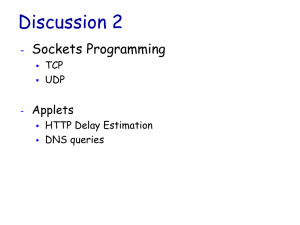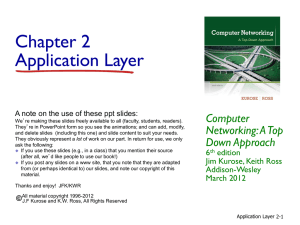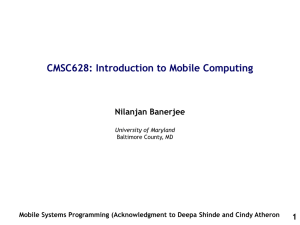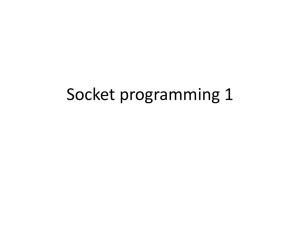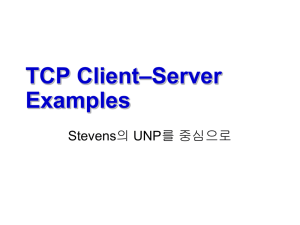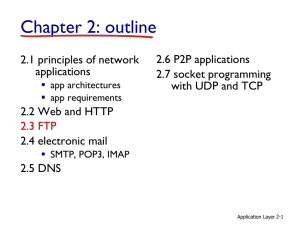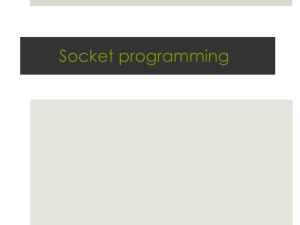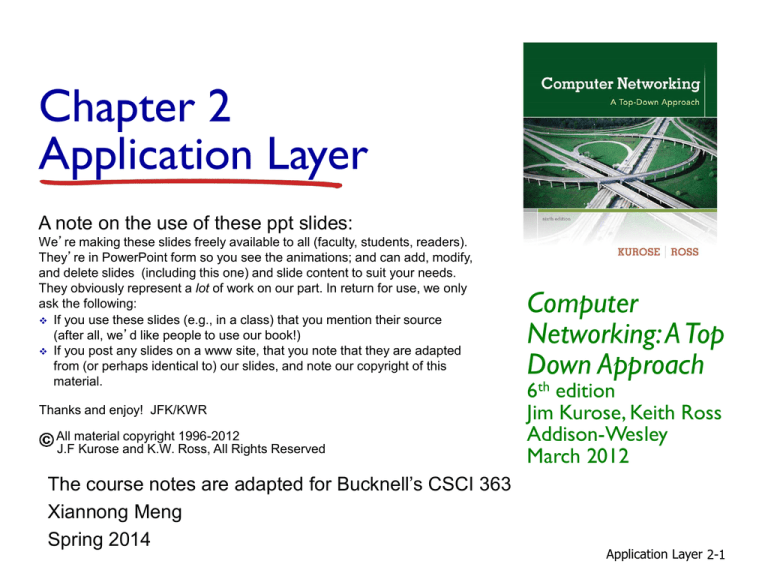
Chapter 2
Application Layer
A note on the use of these ppt slides:
We’re making these slides freely available to all (faculty, students, readers).
They’re in PowerPoint form so you see the animations; and can add, modify,
and delete slides (including this one) and slide content to suit your needs.
They obviously represent a lot of work on our part. In return for use, we only
ask the following:
If you use these slides (e.g., in a class) that you mention their source
(after all, we’d like people to use our book!)
If you post any slides on a www site, that you note that they are adapted
from (or perhaps identical to) our slides, and note our copyright of this
material.
Thanks and enjoy! JFK/KWR
All material copyright 1996-2012
J.F Kurose and K.W. Ross, All Rights Reserved
The course notes are adapted for Bucknell’s CSCI 363
Xiannong Meng
Spring 2014
Computer
Networking: A Top
Down Approach
6th edition
Jim Kurose, Keith Ross
Addison-Wesley
March 2012
Application Layer 2-1
Chapter 2: outline
2.1 principles of network
applications
app architectures
app requirements
2.6 P2P applications
2.7 socket programming
with UDP and TCP
2.2 Web and HTTP
2.3 FTP
2.4 electronic mail
SMTP, POP3, IMAP
2.5 DNS
Application Layer 2-2
Socket programming
goal: learn how to build client/server applications that
communicate using sockets
socket: door between application process and endend-transport protocol
application
process
socket
application
process
transport
transport
network
network
link
physical
Internet
link
controlled by
app developer
controlled
by OS
physical
Application Layer 2-3
Socket programming
Two socket types for two transport services:
UDP: unreliable datagram
TCP: reliable, byte stream-oriented
Application Example:
1.
Client reads a line of characters (data) from its
keyboard and sends the data to the server.
2.
The server receives the data and converts
characters to uppercase.
3.
The server sends the modified data to the client.
4.
The client receives the modified data and displays
the line on its screen.
Application Layer 2-4
Socket programming with UDP
UDP: no “connection” between client & server
no handshaking before sending data
sender explicitly attaches IP destination address and
port # to each packet
rcvr extracts sender IP address and port# from
received packet
UDP: transmitted data may be lost or received
out-of-order
Application viewpoint:
UDP provides unreliable transfer of groups of bytes
(“datagrams”) between client and server
Application Layer 2-5
Client/server socket interaction: UDP
server (running on serverIP)
create socket, port= x:
serverSocket =
socket(AF_INET,SOCK_DGRAM)
read datagram from
serverSocket
write reply to
serverSocket
specifying
client address,
port number
client
create socket:
clientSocket =
socket(AF_INET,SOCK_DGRAM)
Create datagram with server IP and
port=x; send datagram via
clientSocket
read datagram from
clientSocket
close
clientSocket
Application 2-6
Example app: UDP client
Python UDPClient
include Python’s socket
library
from socket import *
serverName = ‘hostname’
serverPort = 12000
create UDP socket for
server
clientSocket = socket(AF_INET,
SOCK_DGRAM)
get user keyboard
input
message = input(’Input lowercase sentence:’)
Attach server name, port to
message; send into socket
clientSocket.sendto(str.encode(message),
(serverName, serverPort))
read reply characters from
socket into string
modifiedMessage, serverAddress =
print out received string
and close socket
print (bytes.decode(modifiedMessage))
clientSocket.recvfrom(2048)
clientSocket.close()
Application Layer 2-7
Example app: UDP server
Python UDPServer
from socket import *
serverPort = 12000
create UDP socket
serverSocket = socket(AF_INET, SOCK_DGRAM)
bind socket to local port
number 12000
serverSocket.bind((‘’, serverPort))
print (“The server is ready to receive” )
loop forever
while 1:
Read from UDP socket into
message, getting client’s
address (client IP and port)
message, clientAddress = serverSocket.recvfrom(2048)
send upper case string
back to this client
serverSocket.sendto(modifiedMessage, clientAddress)
modifiedMessage = message.upper()
Application Layer 2-8
UDP server and client in C
Exact the same functionality can be implemented
in C.
Since the C language is a more primitive, more
complicated code is needed.
See examples/socket.
Basic flow:
Create a socket
Associate the server host information with a socket
address
Bind the client socket to a local address
Send the message to the server (read from client)
Read the echoed message from the server (send back
to the client)
Application Layer 2-9
Socket programming with TCP
client must contact server
server process must first be
running
server must have created
socket (door) that
welcomes client’s contact
client contacts server by:
Creating TCP socket,
specifying IP address, port
number of server process
when client creates socket:
client TCP establishes
connection to server TCP
when contacted by client,
server TCP creates new socket
for server process to
communicate with that
particular client
allows server to talk with
multiple clients
source port numbers used
to distinguish clients
(more in Chap 3)
application viewpoint:
TCP provides reliable, in-order
byte-stream transfer (“pipe”)
between client and server
Application Layer 2-10
Client/server socket interaction: TCP
client
server (running on hostid)
create socket,
port=x, for incoming
request:
serverSocket = socket()
wait for incoming
TCP
connection request
connectionSocket = connection
serverSocket.accept()
read request from
connectionSocket
write reply to
connectionSocket
close
connectionSocket
setup
create socket,
connect to hostid, port=x
clientSocket = socket()
send request using
clientSocket
read reply from
clientSocket
close
clientSocket
Application Layer 2-11
Example app: TCP client
Python TCPClient
from socket import *
serverName = ’servername’
create TCP socket for
server, remote port 12000
serverPort = 12000
clientSocket = socket(AF_INET, SOCK_STREAM)
clientSocket.connect((serverName,serverPort))
sentence = input(‘Input lowercase sentence:’)
No need to attach server
name, port
clientSocket.send(str.encode(sentence))
modifiedSentence = clientSocket.recv(1024)
print (‘From Server: ’, bytes.decode(modifiedSentence))
clientSocket.close()
Application Layer 2-12
Example app: TCP server
Python TCPServer
create TCP welcoming
socket
server begins listening for
incoming TCP requests
loop forever
server waits on accept()
for incoming requests, new
socket created on return
read bytes from socket (but
not address as in UDP)
close connection to this
client (but not welcoming
socket)
from socket import *
serverPort = 12000
serverSocket = socket(AF_INET,SOCK_STREAM)
serverSocket.bind((‘’,serverPort))
serverSocket.listen(1)
print (‘The server is ready to receive’)
while 1:
connectionSocket, addr = serverSocket.accept()
sentence = connectionSocket.recv(1024)
capitalizedSentence = sentence.upper()
connectionSocket.send(capitalizedSentence)
connectionSocket.close()
Application Layer 2-13
TCP server and client in C
Exact the same functionality can be implemented
in C.
Since the C language is a more primitive, more
complicated code is needed.
See examples/socket.
Basic flow:
Create a socket
Associate the server host information with a socket
address
Bind the client socket to a local address
Send the message to the server (read from client)
Read the echoed message from the server (send back
to the client)
Application Layer 2-14


